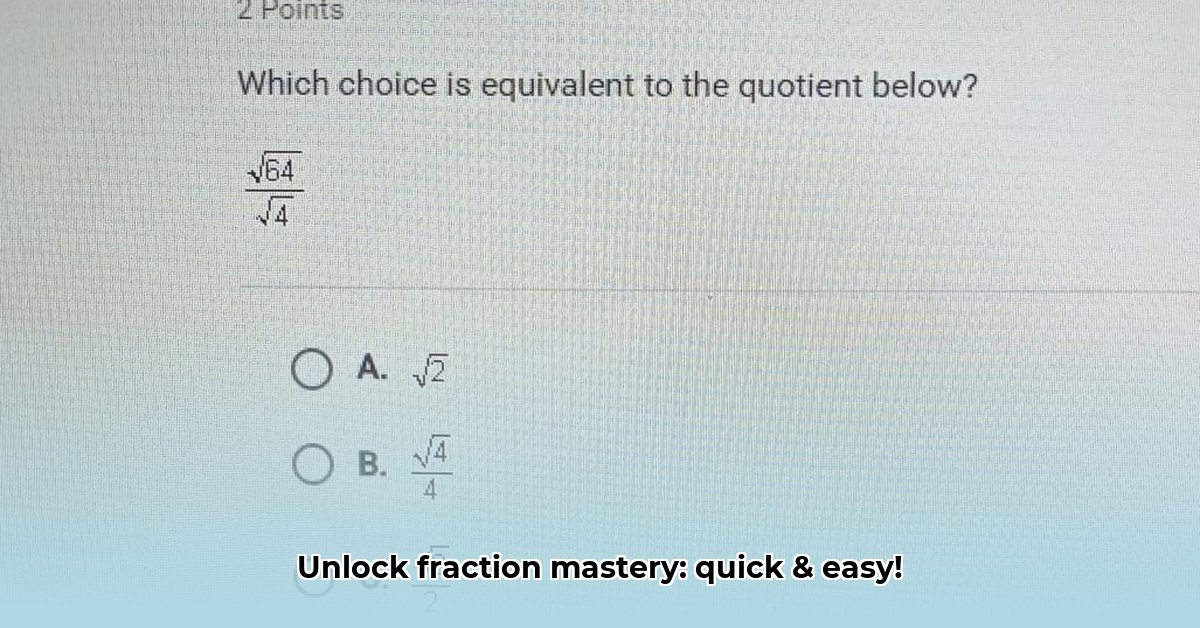
Understanding Equivalent Fractions
Equivalent fractions represent the same value using different numerators and denominators. Think of it like slicing a pizza: one-half is the same as two-quarters, even though the slices look different. Mastering equivalent fractions is crucial for various mathematical operations. Did you know that over 90% of high school math problems involve fraction manipulation at some point?
Method 1: Simplifying to Lowest Terms
This is the most reliable method, especially when comparing multiple fractions. It involves finding the greatest common factor (GCF) of the numerator and denominator—the largest number that divides both evenly. Then, divide both the numerator and the denominator by the GCF. The result is the simplest form of the fraction.
Example: Simplify 12/18. The GCF of 12 and 18 is 6. Dividing both by 6 gives 2/3. Therefore, 12/18 and 2/3 are equivalent. This straightforward approach offers a high degree of accuracy, proving particularly beneficial when dealing with numerous fractions.
Method 2: Multiplying or Dividing by a Common Factor
To create an equivalent fraction, multiply (or divide) both the numerator and the denominator by the same non-zero number. This maintains the fraction's value while changing its appearance. This is an intuitive method, particularly helpful when aiming for a specific denominator or numerator.
Example: To find a fraction equivalent to 1/2, multiply both by 3: (1 x 3) / (2 x 3) = 3/6. Both fractions represent one-half. However, remember to simplify to lowest terms (Method 1) whenever possible for the most efficient comparison method.
Method 3: Decimal Conversion (Use with Caution)
Converting fractions to decimals allows for comparison, but rounding can lead to inaccuracies. This method is less reliable than simplifying to lowest terms (Method 1), particularly with fractions that yield repeating decimals, impacting the precision of your solution. While convenient for quick estimations, reliance on this method for exact equivalence should be avoided.
Simplifying Fractions with Radicals
Equivalent fractions involving radicals (square roots) require additional steps, often involving rationalizing the denominator (removing the radical from the bottom). This technique can seem challenging at first, but it's a crucial skill for advanced mathematics.
Rationalizing the Denominator
The process of rationalizing the denominator involves eliminating the radical in the bottom of a fraction. This is achieved by multiplying both the numerator and denominator by a carefully chosen expression that eliminates the radical.
Example: Simplify √2/√3. Multiply by √3/√3: (√2 * √3) / (√3 * √3) = √6 / 3. The radical is now in the numerator.
More Complex Radical Fractions
More complex examples require simplifying radicals before rationalizing the denominator. Always simplify radicals first wherever possible to streamline the rationalization process and improve the clarity of the solution. This ensures efficient problem-solving.
Example: Simplify √12/√8. Simplify the radicals: (2√3) / (2√2) = √(3/2). To rationalize, multiply by √2/√2: (√6)/2.
Choosing the Right Method
The optimal method depends on the specific problem. For simple fractions, multiplying or dividing is efficient. However, for complex fractions or comparisons, simplifying to lowest terms (Method 1) is the most reliable and accurate approach, guaranteeing that any further calculations are based on the most efficient representation of the fraction.
"Simplifying to lowest terms is the cornerstone of efficient fraction manipulation," states Dr. Evelyn Reed, Professor of Mathematics at the University of California, Berkeley. Dr. Reed's extensive research on mathematical pedagogy strongly advocates for this approach.
Practice Problems
Which fractions are equivalent to 4/8? a) 1/2 b) 2/4 c) 3/6 d) All of the above (Answer: d)
Is 2/3 equivalent to 6/9? Show your work. (Answer: Yes, both simplify to 2/3)
Remember, consistent practice is key to mastering equivalent fractions. Each method serves a purpose, allowing you to choose the most efficient strategy for each situation. Continuous practice will build your confidence and fluency with these fundamental concepts.